International Marketing Analysis of Australian Superfood Co.
VerifiedAdded on 2023/01/04
|13
|3155
|61
Report
AI Summary
This report provides an international marketing analysis for the Australian Superfood Co., focusing on its potential entry into the Indonesian market. The report begins with an executive summary outlining the objectives and key findings. It then delves into a PESTLE analysis to assess the political, economic, social, technological, environmental, and legal factors influencing the business environment in Indonesia. A competitor analysis is conducted to evaluate the competitive landscape, and a positioning map is created to visualize the company's market position. A SWOT analysis identifies internal strengths and weaknesses, as well as external opportunities and threats. Based on these analyses, the report recommends suitable market entry modes, specifically direct exporting and Greenfield investments. The report concludes with a summary of the key findings and recommendations, providing a strategic roadmap for Australian Superfood Co.'s expansion into Indonesia.
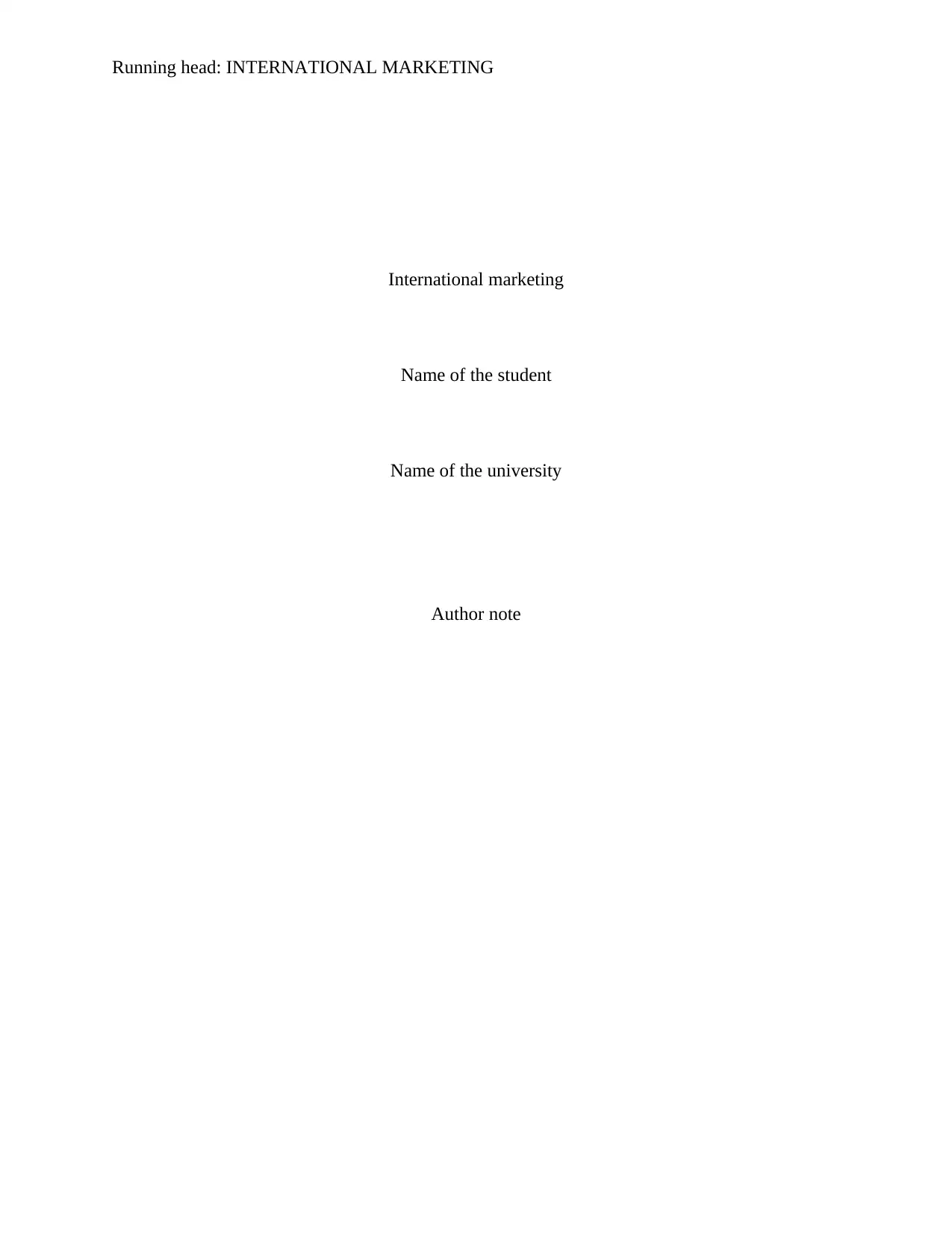
Running head: INTERNATIONAL MARKETING
International marketing
Name of the student
Name of the university
Author note
International marketing
Name of the student
Name of the university
Author note
Paraphrase This Document
Need a fresh take? Get an instant paraphrase of this document with our AI Paraphraser
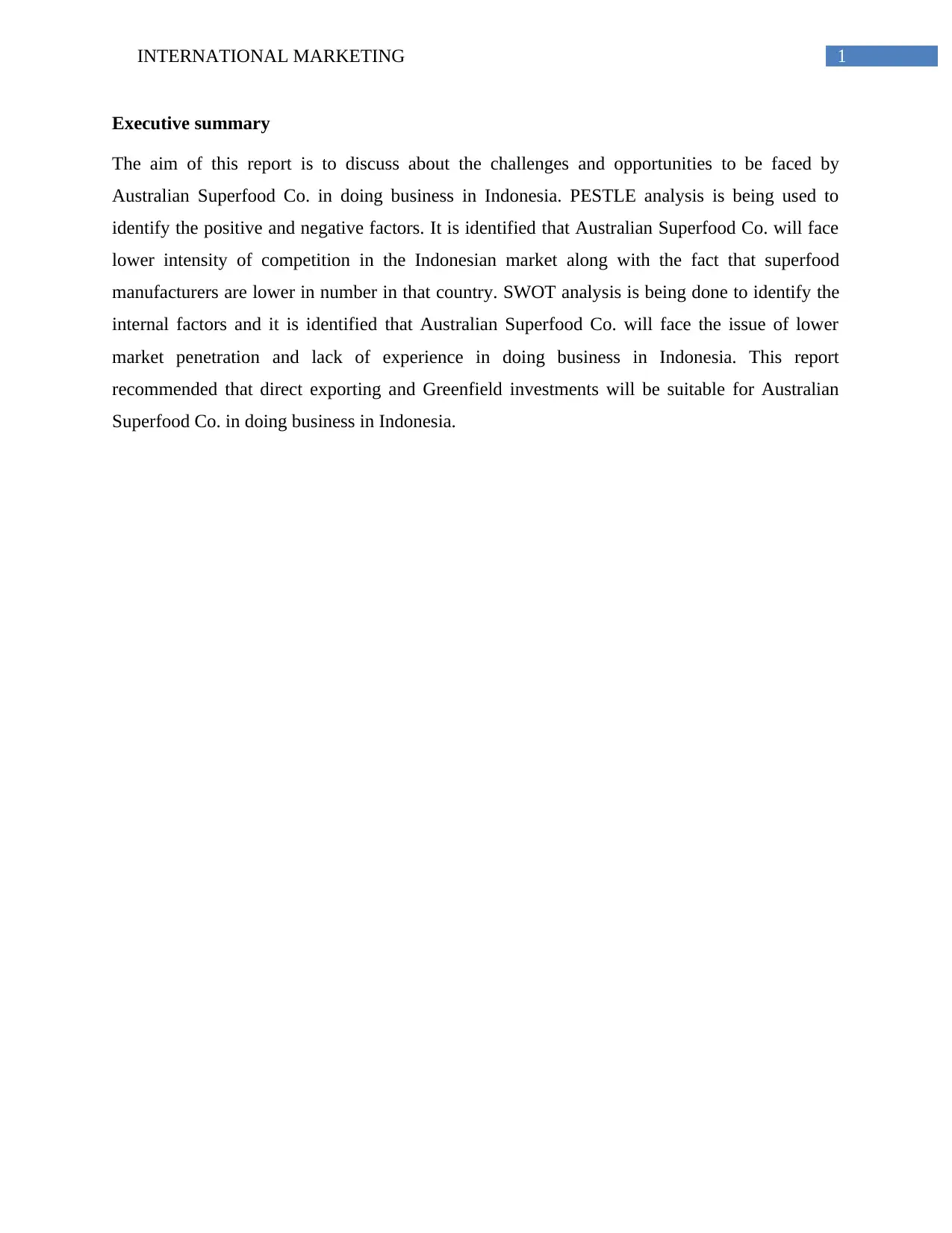
1INTERNATIONAL MARKETING
Executive summary
The aim of this report is to discuss about the challenges and opportunities to be faced by
Australian Superfood Co. in doing business in Indonesia. PESTLE analysis is being used to
identify the positive and negative factors. It is identified that Australian Superfood Co. will face
lower intensity of competition in the Indonesian market along with the fact that superfood
manufacturers are lower in number in that country. SWOT analysis is being done to identify the
internal factors and it is identified that Australian Superfood Co. will face the issue of lower
market penetration and lack of experience in doing business in Indonesia. This report
recommended that direct exporting and Greenfield investments will be suitable for Australian
Superfood Co. in doing business in Indonesia.
Executive summary
The aim of this report is to discuss about the challenges and opportunities to be faced by
Australian Superfood Co. in doing business in Indonesia. PESTLE analysis is being used to
identify the positive and negative factors. It is identified that Australian Superfood Co. will face
lower intensity of competition in the Indonesian market along with the fact that superfood
manufacturers are lower in number in that country. SWOT analysis is being done to identify the
internal factors and it is identified that Australian Superfood Co. will face the issue of lower
market penetration and lack of experience in doing business in Indonesia. This report
recommended that direct exporting and Greenfield investments will be suitable for Australian
Superfood Co. in doing business in Indonesia.
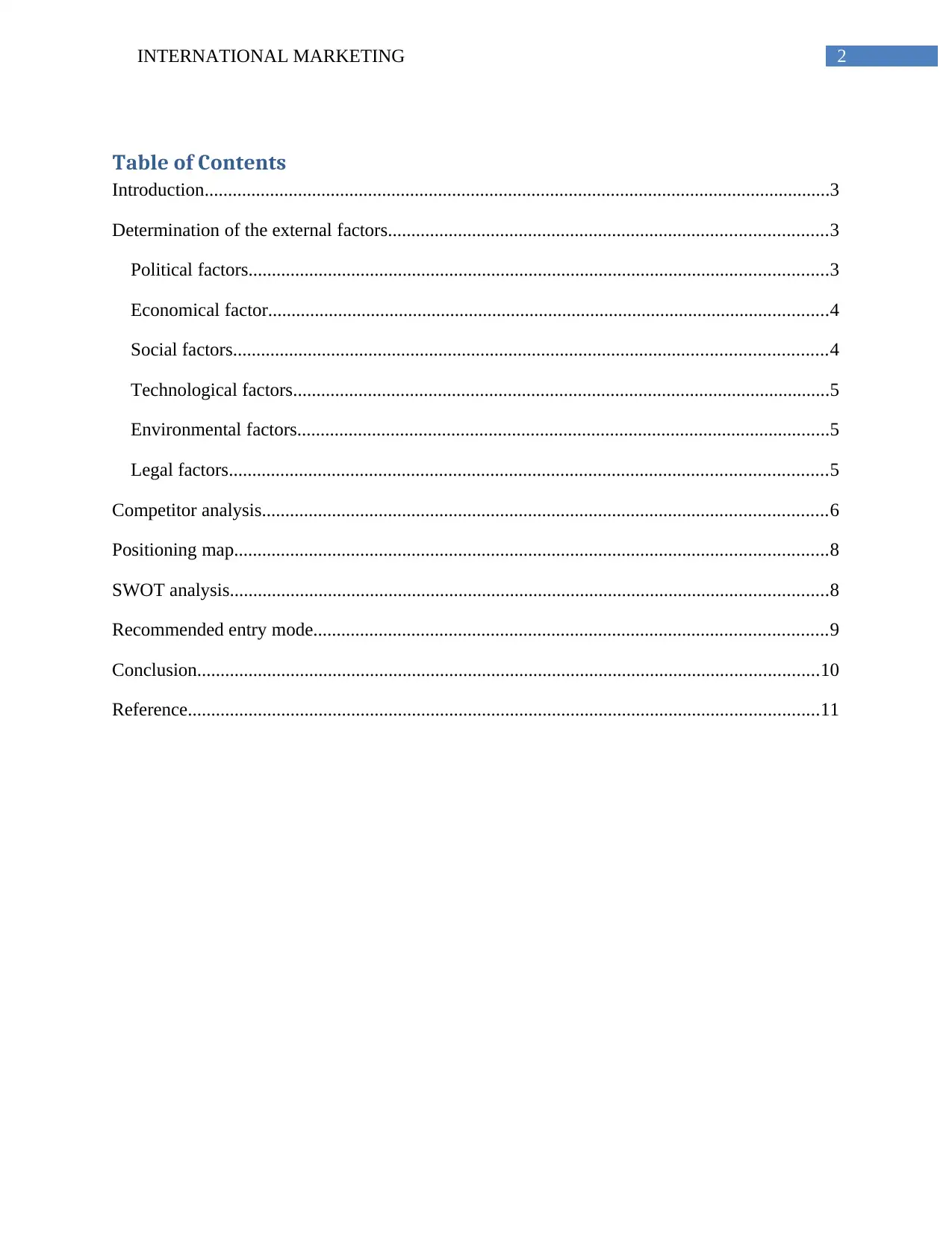
2INTERNATIONAL MARKETING
Table of Contents
Introduction......................................................................................................................................3
Determination of the external factors..............................................................................................3
Political factors............................................................................................................................3
Economical factor........................................................................................................................4
Social factors...............................................................................................................................4
Technological factors...................................................................................................................5
Environmental factors..................................................................................................................5
Legal factors................................................................................................................................5
Competitor analysis.........................................................................................................................6
Positioning map...............................................................................................................................8
SWOT analysis................................................................................................................................8
Recommended entry mode..............................................................................................................9
Conclusion.....................................................................................................................................10
Reference.......................................................................................................................................11
Table of Contents
Introduction......................................................................................................................................3
Determination of the external factors..............................................................................................3
Political factors............................................................................................................................3
Economical factor........................................................................................................................4
Social factors...............................................................................................................................4
Technological factors...................................................................................................................5
Environmental factors..................................................................................................................5
Legal factors................................................................................................................................5
Competitor analysis.........................................................................................................................6
Positioning map...............................................................................................................................8
SWOT analysis................................................................................................................................8
Recommended entry mode..............................................................................................................9
Conclusion.....................................................................................................................................10
Reference.......................................................................................................................................11
⊘ This is a preview!⊘
Do you want full access?
Subscribe today to unlock all pages.

Trusted by 1+ million students worldwide
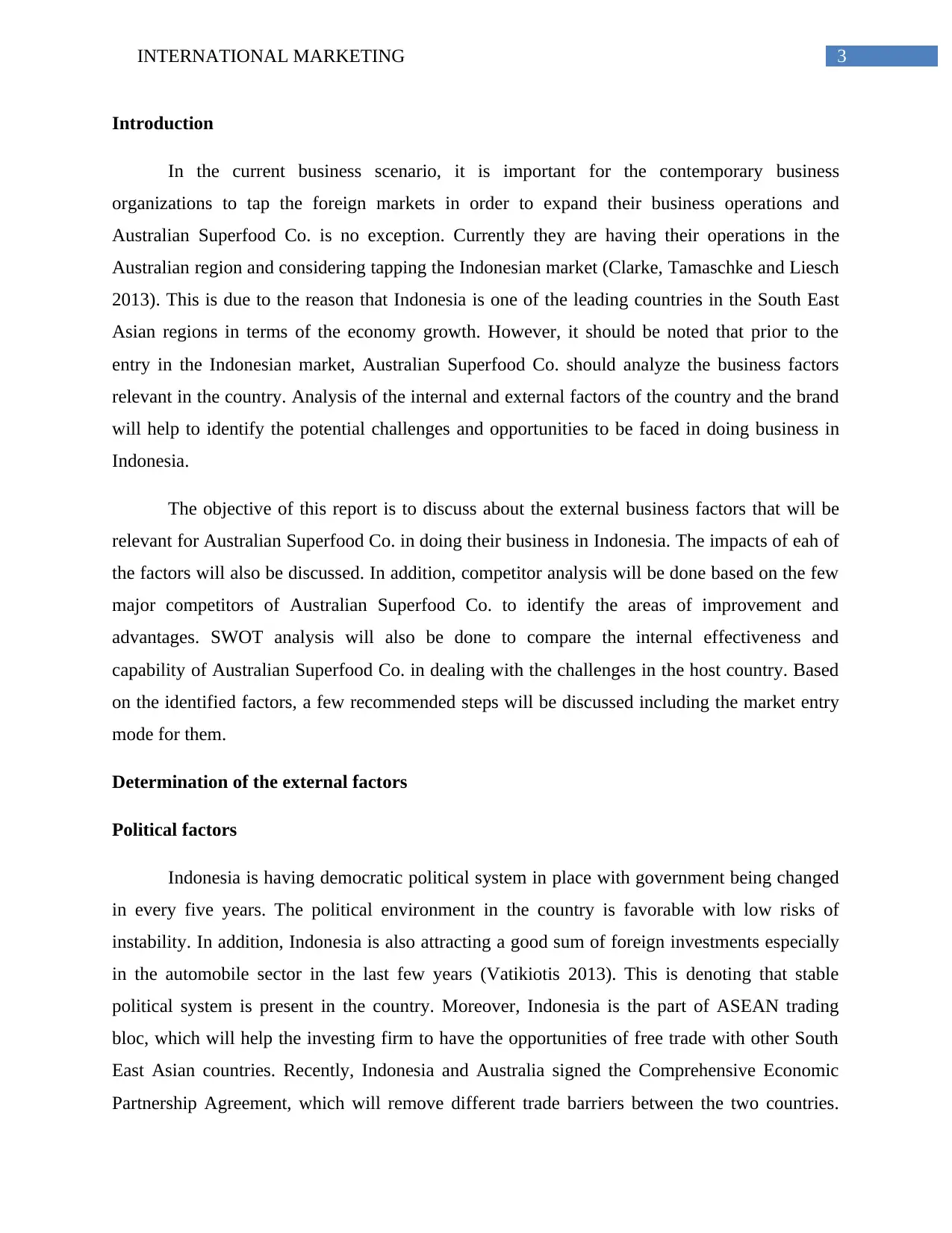
3INTERNATIONAL MARKETING
Introduction
In the current business scenario, it is important for the contemporary business
organizations to tap the foreign markets in order to expand their business operations and
Australian Superfood Co. is no exception. Currently they are having their operations in the
Australian region and considering tapping the Indonesian market (Clarke, Tamaschke and Liesch
2013). This is due to the reason that Indonesia is one of the leading countries in the South East
Asian regions in terms of the economy growth. However, it should be noted that prior to the
entry in the Indonesian market, Australian Superfood Co. should analyze the business factors
relevant in the country. Analysis of the internal and external factors of the country and the brand
will help to identify the potential challenges and opportunities to be faced in doing business in
Indonesia.
The objective of this report is to discuss about the external business factors that will be
relevant for Australian Superfood Co. in doing their business in Indonesia. The impacts of eah of
the factors will also be discussed. In addition, competitor analysis will be done based on the few
major competitors of Australian Superfood Co. to identify the areas of improvement and
advantages. SWOT analysis will also be done to compare the internal effectiveness and
capability of Australian Superfood Co. in dealing with the challenges in the host country. Based
on the identified factors, a few recommended steps will be discussed including the market entry
mode for them.
Determination of the external factors
Political factors
Indonesia is having democratic political system in place with government being changed
in every five years. The political environment in the country is favorable with low risks of
instability. In addition, Indonesia is also attracting a good sum of foreign investments especially
in the automobile sector in the last few years (Vatikiotis 2013). This is denoting that stable
political system is present in the country. Moreover, Indonesia is the part of ASEAN trading
bloc, which will help the investing firm to have the opportunities of free trade with other South
East Asian countries. Recently, Indonesia and Australia signed the Comprehensive Economic
Partnership Agreement, which will remove different trade barriers between the two countries.
Introduction
In the current business scenario, it is important for the contemporary business
organizations to tap the foreign markets in order to expand their business operations and
Australian Superfood Co. is no exception. Currently they are having their operations in the
Australian region and considering tapping the Indonesian market (Clarke, Tamaschke and Liesch
2013). This is due to the reason that Indonesia is one of the leading countries in the South East
Asian regions in terms of the economy growth. However, it should be noted that prior to the
entry in the Indonesian market, Australian Superfood Co. should analyze the business factors
relevant in the country. Analysis of the internal and external factors of the country and the brand
will help to identify the potential challenges and opportunities to be faced in doing business in
Indonesia.
The objective of this report is to discuss about the external business factors that will be
relevant for Australian Superfood Co. in doing their business in Indonesia. The impacts of eah of
the factors will also be discussed. In addition, competitor analysis will be done based on the few
major competitors of Australian Superfood Co. to identify the areas of improvement and
advantages. SWOT analysis will also be done to compare the internal effectiveness and
capability of Australian Superfood Co. in dealing with the challenges in the host country. Based
on the identified factors, a few recommended steps will be discussed including the market entry
mode for them.
Determination of the external factors
Political factors
Indonesia is having democratic political system in place with government being changed
in every five years. The political environment in the country is favorable with low risks of
instability. In addition, Indonesia is also attracting a good sum of foreign investments especially
in the automobile sector in the last few years (Vatikiotis 2013). This is denoting that stable
political system is present in the country. Moreover, Indonesia is the part of ASEAN trading
bloc, which will help the investing firm to have the opportunities of free trade with other South
East Asian countries. Recently, Indonesia and Australia signed the Comprehensive Economic
Partnership Agreement, which will remove different trade barriers between the two countries.
Paraphrase This Document
Need a fresh take? Get an instant paraphrase of this document with our AI Paraphraser
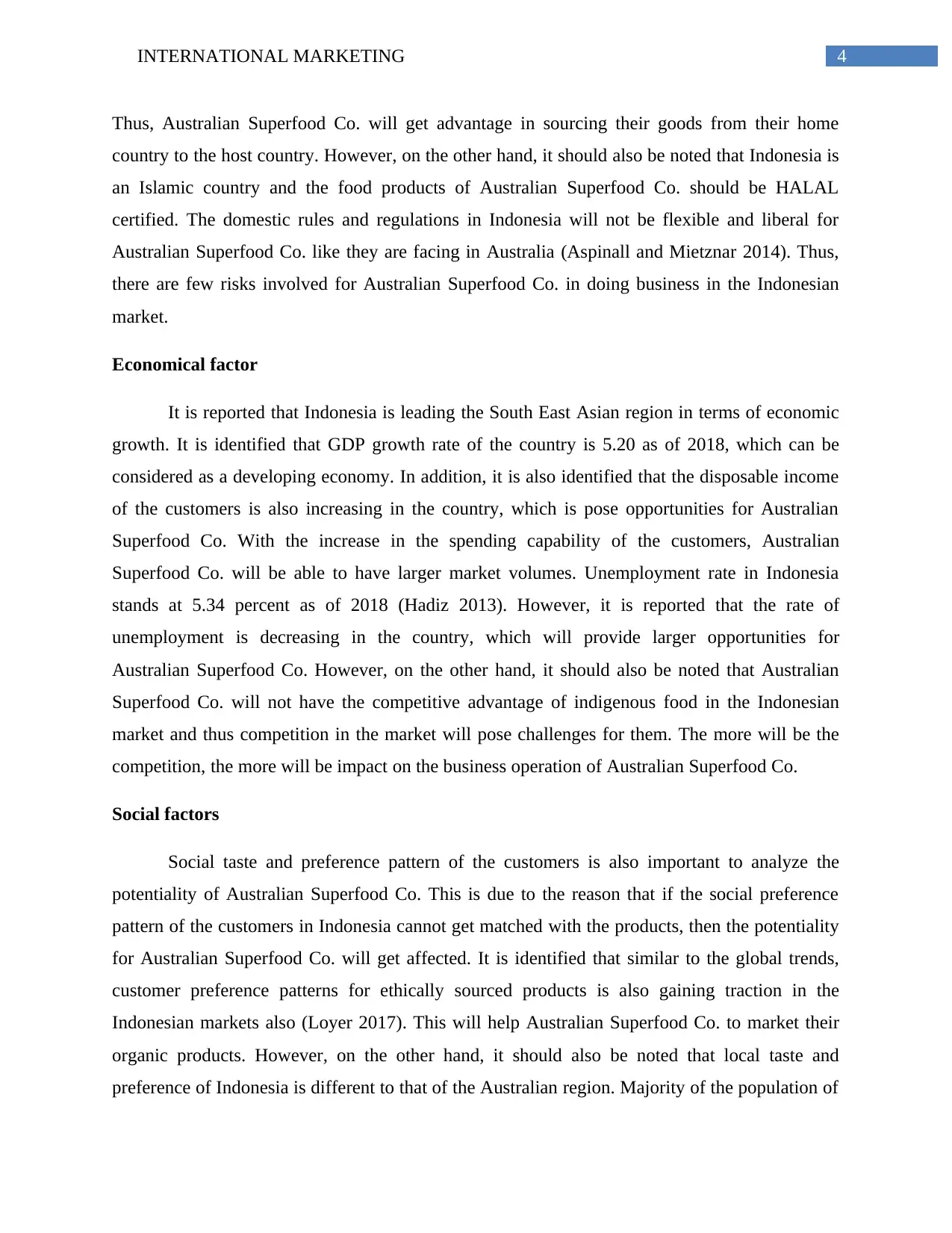
4INTERNATIONAL MARKETING
Thus, Australian Superfood Co. will get advantage in sourcing their goods from their home
country to the host country. However, on the other hand, it should also be noted that Indonesia is
an Islamic country and the food products of Australian Superfood Co. should be HALAL
certified. The domestic rules and regulations in Indonesia will not be flexible and liberal for
Australian Superfood Co. like they are facing in Australia (Aspinall and Mietznar 2014). Thus,
there are few risks involved for Australian Superfood Co. in doing business in the Indonesian
market.
Economical factor
It is reported that Indonesia is leading the South East Asian region in terms of economic
growth. It is identified that GDP growth rate of the country is 5.20 as of 2018, which can be
considered as a developing economy. In addition, it is also identified that the disposable income
of the customers is also increasing in the country, which is pose opportunities for Australian
Superfood Co. With the increase in the spending capability of the customers, Australian
Superfood Co. will be able to have larger market volumes. Unemployment rate in Indonesia
stands at 5.34 percent as of 2018 (Hadiz 2013). However, it is reported that the rate of
unemployment is decreasing in the country, which will provide larger opportunities for
Australian Superfood Co. However, on the other hand, it should also be noted that Australian
Superfood Co. will not have the competitive advantage of indigenous food in the Indonesian
market and thus competition in the market will pose challenges for them. The more will be the
competition, the more will be impact on the business operation of Australian Superfood Co.
Social factors
Social taste and preference pattern of the customers is also important to analyze the
potentiality of Australian Superfood Co. This is due to the reason that if the social preference
pattern of the customers in Indonesia cannot get matched with the products, then the potentiality
for Australian Superfood Co. will get affected. It is identified that similar to the global trends,
customer preference patterns for ethically sourced products is also gaining traction in the
Indonesian markets also (Loyer 2017). This will help Australian Superfood Co. to market their
organic products. However, on the other hand, it should also be noted that local taste and
preference of Indonesia is different to that of the Australian region. Majority of the population of
Thus, Australian Superfood Co. will get advantage in sourcing their goods from their home
country to the host country. However, on the other hand, it should also be noted that Indonesia is
an Islamic country and the food products of Australian Superfood Co. should be HALAL
certified. The domestic rules and regulations in Indonesia will not be flexible and liberal for
Australian Superfood Co. like they are facing in Australia (Aspinall and Mietznar 2014). Thus,
there are few risks involved for Australian Superfood Co. in doing business in the Indonesian
market.
Economical factor
It is reported that Indonesia is leading the South East Asian region in terms of economic
growth. It is identified that GDP growth rate of the country is 5.20 as of 2018, which can be
considered as a developing economy. In addition, it is also identified that the disposable income
of the customers is also increasing in the country, which is pose opportunities for Australian
Superfood Co. With the increase in the spending capability of the customers, Australian
Superfood Co. will be able to have larger market volumes. Unemployment rate in Indonesia
stands at 5.34 percent as of 2018 (Hadiz 2013). However, it is reported that the rate of
unemployment is decreasing in the country, which will provide larger opportunities for
Australian Superfood Co. However, on the other hand, it should also be noted that Australian
Superfood Co. will not have the competitive advantage of indigenous food in the Indonesian
market and thus competition in the market will pose challenges for them. The more will be the
competition, the more will be impact on the business operation of Australian Superfood Co.
Social factors
Social taste and preference pattern of the customers is also important to analyze the
potentiality of Australian Superfood Co. This is due to the reason that if the social preference
pattern of the customers in Indonesia cannot get matched with the products, then the potentiality
for Australian Superfood Co. will get affected. It is identified that similar to the global trends,
customer preference patterns for ethically sourced products is also gaining traction in the
Indonesian markets also (Loyer 2017). This will help Australian Superfood Co. to market their
organic products. However, on the other hand, it should also be noted that local taste and
preference of Indonesia is different to that of the Australian region. Majority of the population of
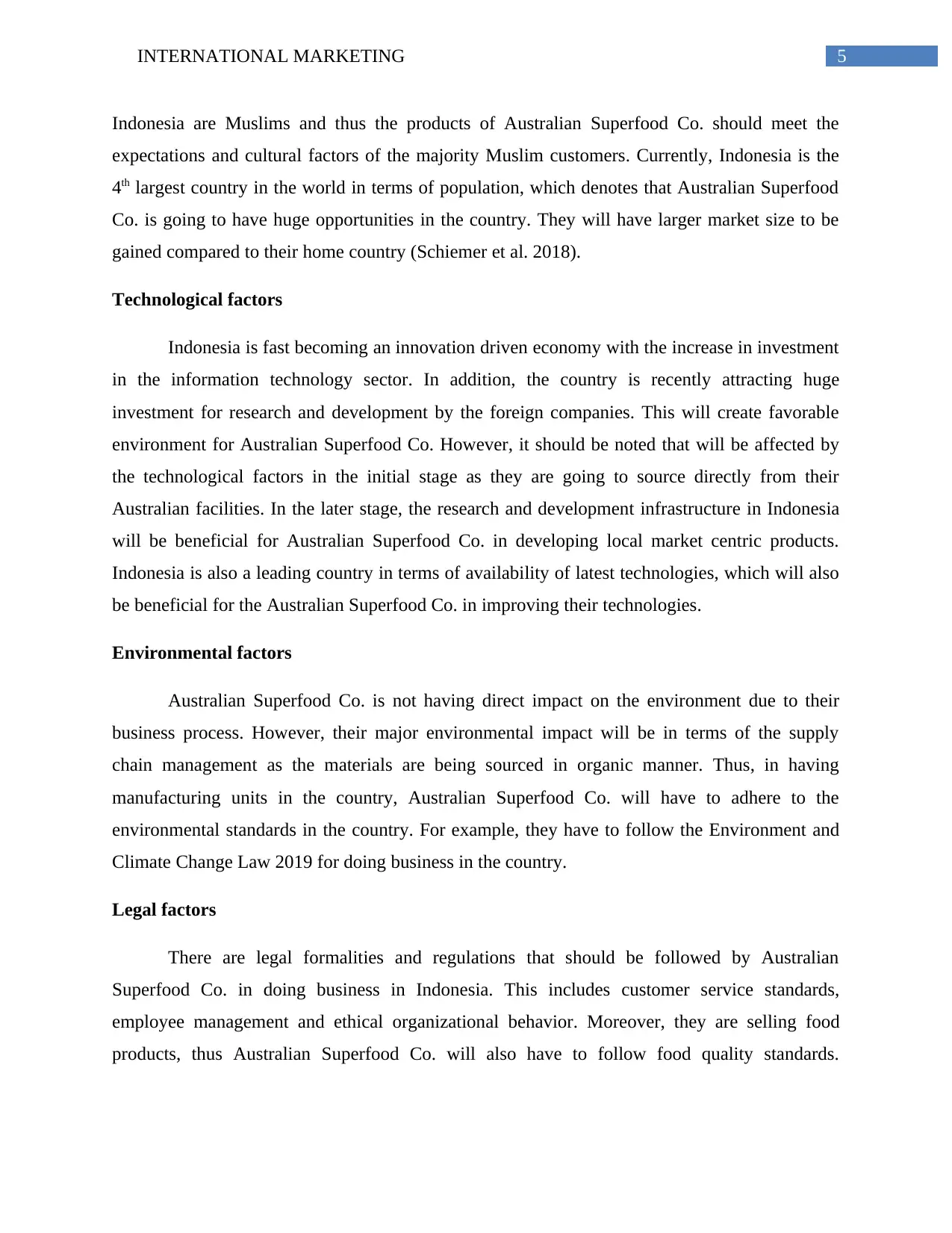
5INTERNATIONAL MARKETING
Indonesia are Muslims and thus the products of Australian Superfood Co. should meet the
expectations and cultural factors of the majority Muslim customers. Currently, Indonesia is the
4th largest country in the world in terms of population, which denotes that Australian Superfood
Co. is going to have huge opportunities in the country. They will have larger market size to be
gained compared to their home country (Schiemer et al. 2018).
Technological factors
Indonesia is fast becoming an innovation driven economy with the increase in investment
in the information technology sector. In addition, the country is recently attracting huge
investment for research and development by the foreign companies. This will create favorable
environment for Australian Superfood Co. However, it should be noted that will be affected by
the technological factors in the initial stage as they are going to source directly from their
Australian facilities. In the later stage, the research and development infrastructure in Indonesia
will be beneficial for Australian Superfood Co. in developing local market centric products.
Indonesia is also a leading country in terms of availability of latest technologies, which will also
be beneficial for the Australian Superfood Co. in improving their technologies.
Environmental factors
Australian Superfood Co. is not having direct impact on the environment due to their
business process. However, their major environmental impact will be in terms of the supply
chain management as the materials are being sourced in organic manner. Thus, in having
manufacturing units in the country, Australian Superfood Co. will have to adhere to the
environmental standards in the country. For example, they have to follow the Environment and
Climate Change Law 2019 for doing business in the country.
Legal factors
There are legal formalities and regulations that should be followed by Australian
Superfood Co. in doing business in Indonesia. This includes customer service standards,
employee management and ethical organizational behavior. Moreover, they are selling food
products, thus Australian Superfood Co. will also have to follow food quality standards.
Indonesia are Muslims and thus the products of Australian Superfood Co. should meet the
expectations and cultural factors of the majority Muslim customers. Currently, Indonesia is the
4th largest country in the world in terms of population, which denotes that Australian Superfood
Co. is going to have huge opportunities in the country. They will have larger market size to be
gained compared to their home country (Schiemer et al. 2018).
Technological factors
Indonesia is fast becoming an innovation driven economy with the increase in investment
in the information technology sector. In addition, the country is recently attracting huge
investment for research and development by the foreign companies. This will create favorable
environment for Australian Superfood Co. However, it should be noted that will be affected by
the technological factors in the initial stage as they are going to source directly from their
Australian facilities. In the later stage, the research and development infrastructure in Indonesia
will be beneficial for Australian Superfood Co. in developing local market centric products.
Indonesia is also a leading country in terms of availability of latest technologies, which will also
be beneficial for the Australian Superfood Co. in improving their technologies.
Environmental factors
Australian Superfood Co. is not having direct impact on the environment due to their
business process. However, their major environmental impact will be in terms of the supply
chain management as the materials are being sourced in organic manner. Thus, in having
manufacturing units in the country, Australian Superfood Co. will have to adhere to the
environmental standards in the country. For example, they have to follow the Environment and
Climate Change Law 2019 for doing business in the country.
Legal factors
There are legal formalities and regulations that should be followed by Australian
Superfood Co. in doing business in Indonesia. This includes customer service standards,
employee management and ethical organizational behavior. Moreover, they are selling food
products, thus Australian Superfood Co. will also have to follow food quality standards.
⊘ This is a preview!⊘
Do you want full access?
Subscribe today to unlock all pages.

Trusted by 1+ million students worldwide
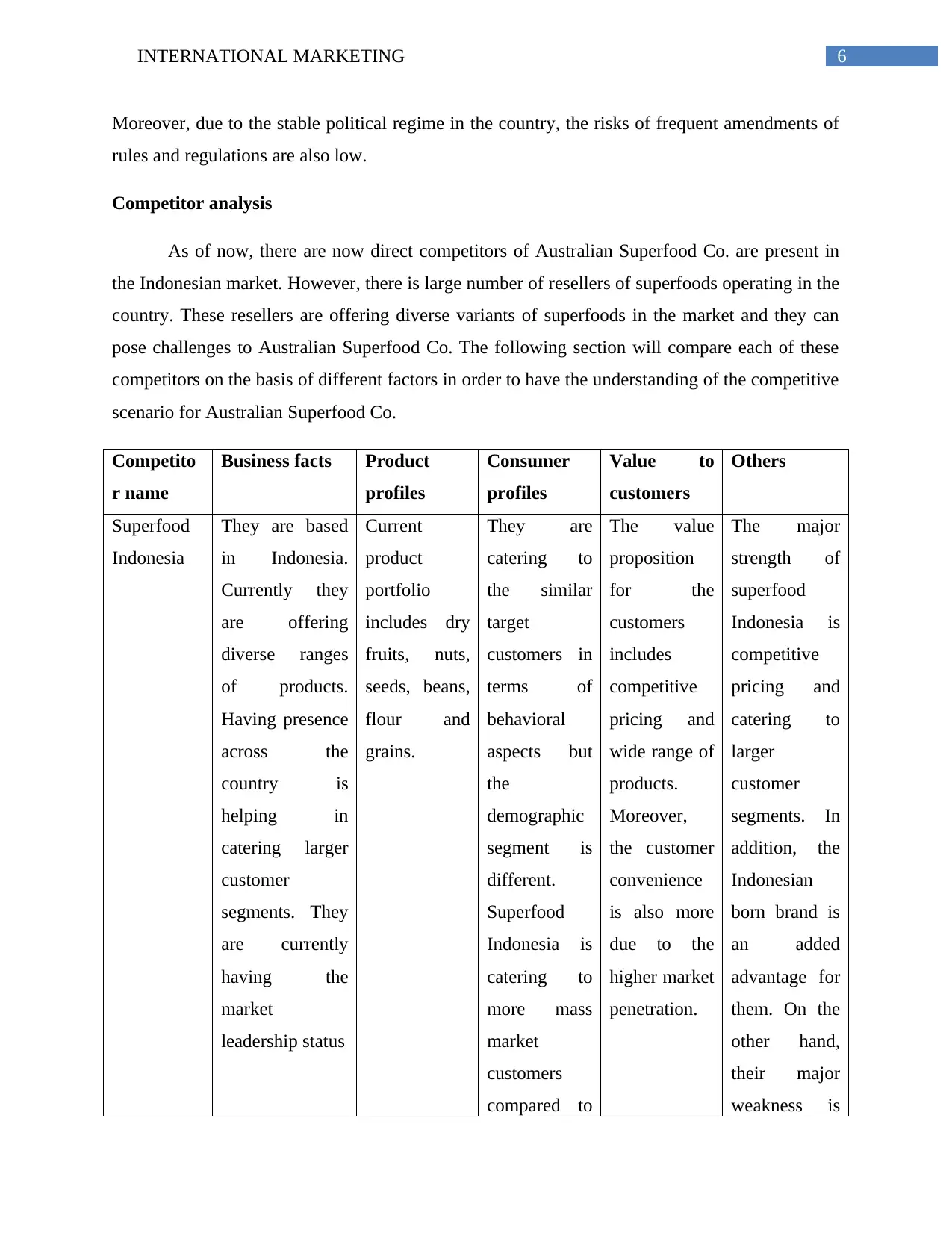
6INTERNATIONAL MARKETING
Moreover, due to the stable political regime in the country, the risks of frequent amendments of
rules and regulations are also low.
Competitor analysis
As of now, there are now direct competitors of Australian Superfood Co. are present in
the Indonesian market. However, there is large number of resellers of superfoods operating in the
country. These resellers are offering diverse variants of superfoods in the market and they can
pose challenges to Australian Superfood Co. The following section will compare each of these
competitors on the basis of different factors in order to have the understanding of the competitive
scenario for Australian Superfood Co.
Competito
r name
Business facts Product
profiles
Consumer
profiles
Value to
customers
Others
Superfood
Indonesia
They are based
in Indonesia.
Currently they
are offering
diverse ranges
of products.
Having presence
across the
country is
helping in
catering larger
customer
segments. They
are currently
having the
market
leadership status
Current
product
portfolio
includes dry
fruits, nuts,
seeds, beans,
flour and
grains.
They are
catering to
the similar
target
customers in
terms of
behavioral
aspects but
the
demographic
segment is
different.
Superfood
Indonesia is
catering to
more mass
market
customers
compared to
The value
proposition
for the
customers
includes
competitive
pricing and
wide range of
products.
Moreover,
the customer
convenience
is also more
due to the
higher market
penetration.
The major
strength of
superfood
Indonesia is
competitive
pricing and
catering to
larger
customer
segments. In
addition, the
Indonesian
born brand is
an added
advantage for
them. On the
other hand,
their major
weakness is
Moreover, due to the stable political regime in the country, the risks of frequent amendments of
rules and regulations are also low.
Competitor analysis
As of now, there are now direct competitors of Australian Superfood Co. are present in
the Indonesian market. However, there is large number of resellers of superfoods operating in the
country. These resellers are offering diverse variants of superfoods in the market and they can
pose challenges to Australian Superfood Co. The following section will compare each of these
competitors on the basis of different factors in order to have the understanding of the competitive
scenario for Australian Superfood Co.
Competito
r name
Business facts Product
profiles
Consumer
profiles
Value to
customers
Others
Superfood
Indonesia
They are based
in Indonesia.
Currently they
are offering
diverse ranges
of products.
Having presence
across the
country is
helping in
catering larger
customer
segments. They
are currently
having the
market
leadership status
Current
product
portfolio
includes dry
fruits, nuts,
seeds, beans,
flour and
grains.
They are
catering to
the similar
target
customers in
terms of
behavioral
aspects but
the
demographic
segment is
different.
Superfood
Indonesia is
catering to
more mass
market
customers
compared to
The value
proposition
for the
customers
includes
competitive
pricing and
wide range of
products.
Moreover,
the customer
convenience
is also more
due to the
higher market
penetration.
The major
strength of
superfood
Indonesia is
competitive
pricing and
catering to
larger
customer
segments. In
addition, the
Indonesian
born brand is
an added
advantage for
them. On the
other hand,
their major
weakness is
Paraphrase This Document
Need a fresh take? Get an instant paraphrase of this document with our AI Paraphraser
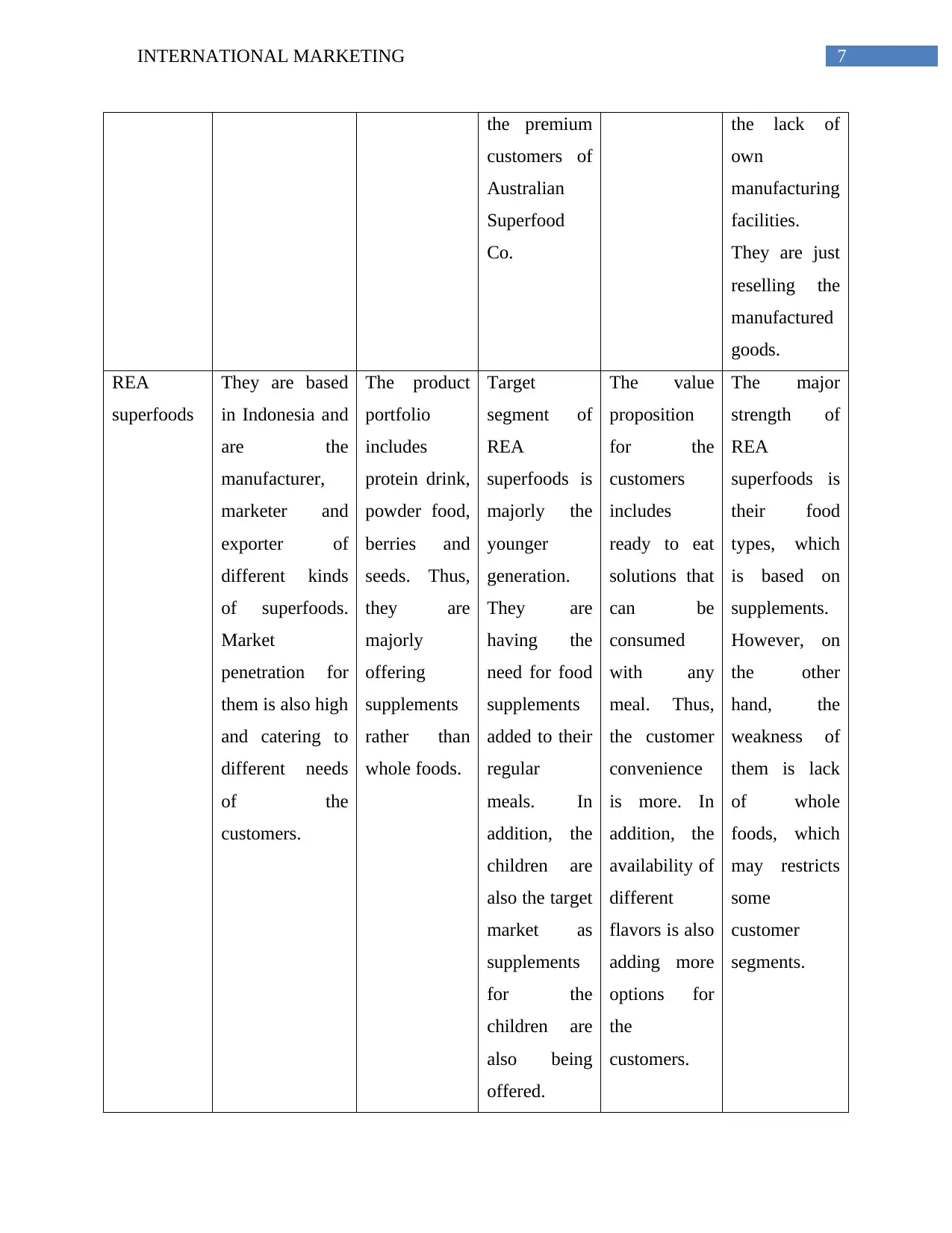
7INTERNATIONAL MARKETING
the premium
customers of
Australian
Superfood
Co.
the lack of
own
manufacturing
facilities.
They are just
reselling the
manufactured
goods.
REA
superfoods
They are based
in Indonesia and
are the
manufacturer,
marketer and
exporter of
different kinds
of superfoods.
Market
penetration for
them is also high
and catering to
different needs
of the
customers.
The product
portfolio
includes
protein drink,
powder food,
berries and
seeds. Thus,
they are
majorly
offering
supplements
rather than
whole foods.
Target
segment of
REA
superfoods is
majorly the
younger
generation.
They are
having the
need for food
supplements
added to their
regular
meals. In
addition, the
children are
also the target
market as
supplements
for the
children are
also being
offered.
The value
proposition
for the
customers
includes
ready to eat
solutions that
can be
consumed
with any
meal. Thus,
the customer
convenience
is more. In
addition, the
availability of
different
flavors is also
adding more
options for
the
customers.
The major
strength of
REA
superfoods is
their food
types, which
is based on
supplements.
However, on
the other
hand, the
weakness of
them is lack
of whole
foods, which
may restricts
some
customer
segments.
the premium
customers of
Australian
Superfood
Co.
the lack of
own
manufacturing
facilities.
They are just
reselling the
manufactured
goods.
REA
superfoods
They are based
in Indonesia and
are the
manufacturer,
marketer and
exporter of
different kinds
of superfoods.
Market
penetration for
them is also high
and catering to
different needs
of the
customers.
The product
portfolio
includes
protein drink,
powder food,
berries and
seeds. Thus,
they are
majorly
offering
supplements
rather than
whole foods.
Target
segment of
REA
superfoods is
majorly the
younger
generation.
They are
having the
need for food
supplements
added to their
regular
meals. In
addition, the
children are
also the target
market as
supplements
for the
children are
also being
offered.
The value
proposition
for the
customers
includes
ready to eat
solutions that
can be
consumed
with any
meal. Thus,
the customer
convenience
is more. In
addition, the
availability of
different
flavors is also
adding more
options for
the
customers.
The major
strength of
REA
superfoods is
their food
types, which
is based on
supplements.
However, on
the other
hand, the
weakness of
them is lack
of whole
foods, which
may restricts
some
customer
segments.
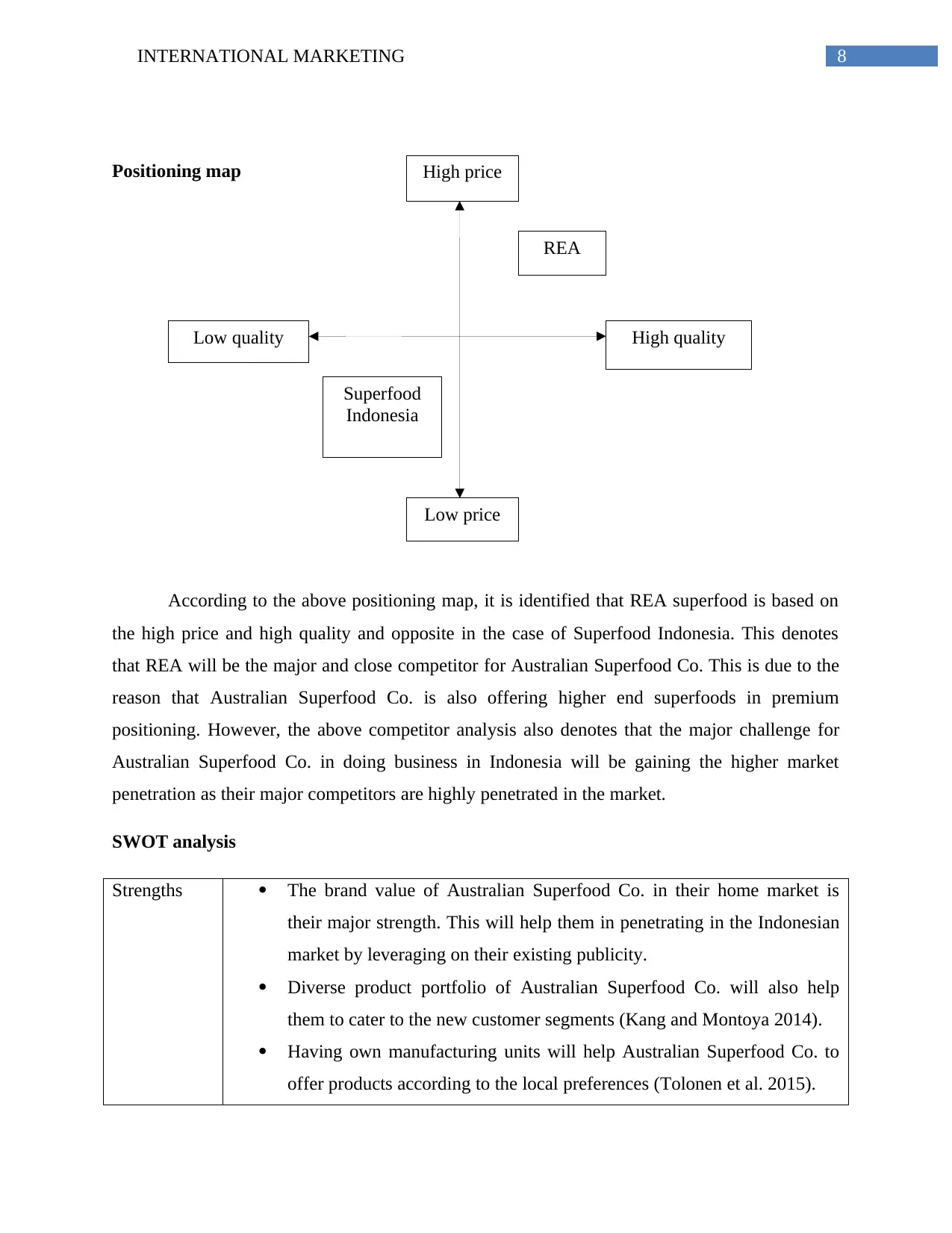
8INTERNATIONAL MARKETING
High price
Low price
Low quality High quality
REA
Superfood
Indonesia
Positioning map
According to the above positioning map, it is identified that REA superfood is based on
the high price and high quality and opposite in the case of Superfood Indonesia. This denotes
that REA will be the major and close competitor for Australian Superfood Co. This is due to the
reason that Australian Superfood Co. is also offering higher end superfoods in premium
positioning. However, the above competitor analysis also denotes that the major challenge for
Australian Superfood Co. in doing business in Indonesia will be gaining the higher market
penetration as their major competitors are highly penetrated in the market.
SWOT analysis
Strengths The brand value of Australian Superfood Co. in their home market is
their major strength. This will help them in penetrating in the Indonesian
market by leveraging on their existing publicity.
Diverse product portfolio of Australian Superfood Co. will also help
them to cater to the new customer segments (Kang and Montoya 2014).
Having own manufacturing units will help Australian Superfood Co. to
offer products according to the local preferences (Tolonen et al. 2015).
High price
Low price
Low quality High quality
REA
Superfood
Indonesia
Positioning map
According to the above positioning map, it is identified that REA superfood is based on
the high price and high quality and opposite in the case of Superfood Indonesia. This denotes
that REA will be the major and close competitor for Australian Superfood Co. This is due to the
reason that Australian Superfood Co. is also offering higher end superfoods in premium
positioning. However, the above competitor analysis also denotes that the major challenge for
Australian Superfood Co. in doing business in Indonesia will be gaining the higher market
penetration as their major competitors are highly penetrated in the market.
SWOT analysis
Strengths The brand value of Australian Superfood Co. in their home market is
their major strength. This will help them in penetrating in the Indonesian
market by leveraging on their existing publicity.
Diverse product portfolio of Australian Superfood Co. will also help
them to cater to the new customer segments (Kang and Montoya 2014).
Having own manufacturing units will help Australian Superfood Co. to
offer products according to the local preferences (Tolonen et al. 2015).
⊘ This is a preview!⊘
Do you want full access?
Subscribe today to unlock all pages.

Trusted by 1+ million students worldwide
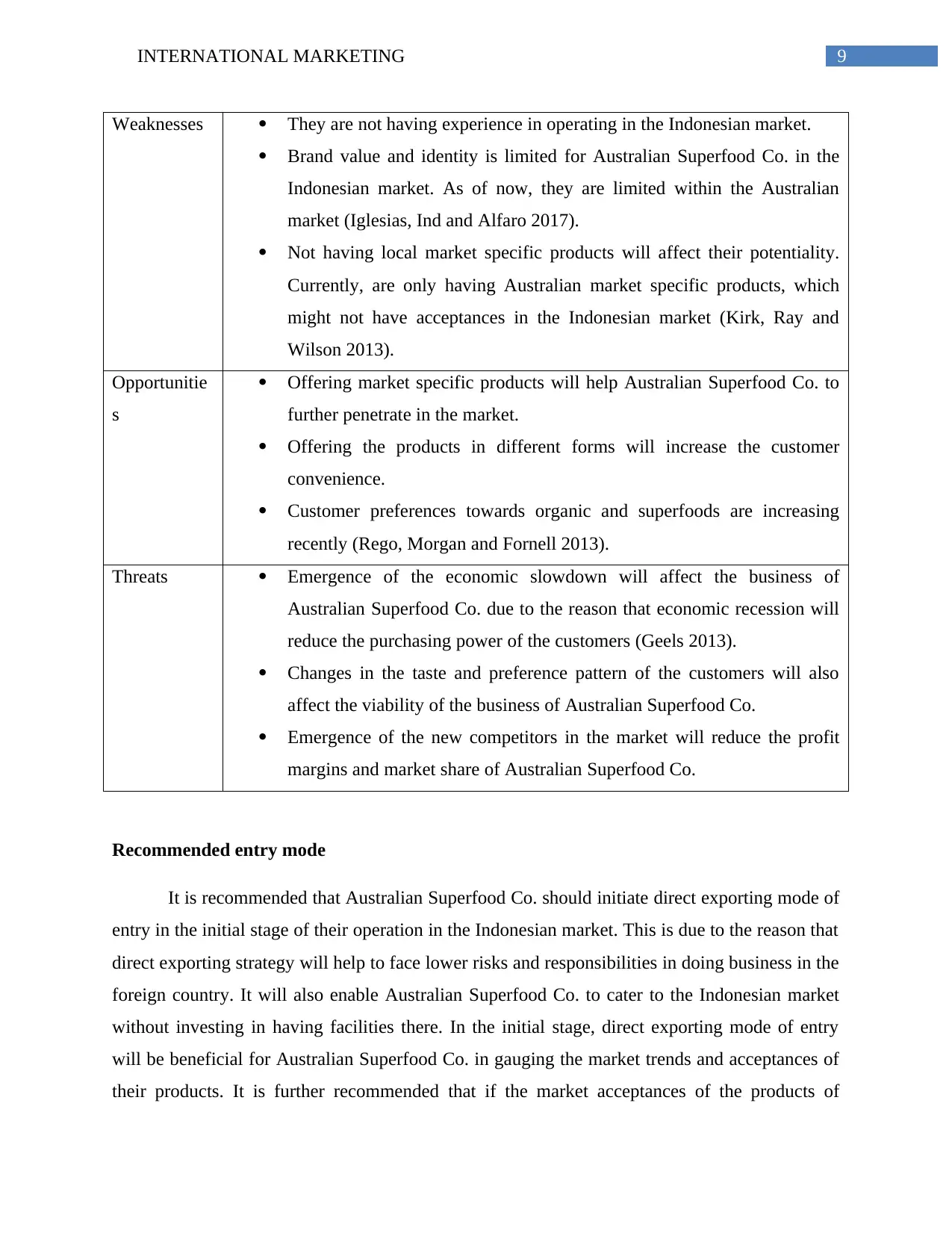
9INTERNATIONAL MARKETING
Weaknesses They are not having experience in operating in the Indonesian market.
Brand value and identity is limited for Australian Superfood Co. in the
Indonesian market. As of now, they are limited within the Australian
market (Iglesias, Ind and Alfaro 2017).
Not having local market specific products will affect their potentiality.
Currently, are only having Australian market specific products, which
might not have acceptances in the Indonesian market (Kirk, Ray and
Wilson 2013).
Opportunitie
s
Offering market specific products will help Australian Superfood Co. to
further penetrate in the market.
Offering the products in different forms will increase the customer
convenience.
Customer preferences towards organic and superfoods are increasing
recently (Rego, Morgan and Fornell 2013).
Threats Emergence of the economic slowdown will affect the business of
Australian Superfood Co. due to the reason that economic recession will
reduce the purchasing power of the customers (Geels 2013).
Changes in the taste and preference pattern of the customers will also
affect the viability of the business of Australian Superfood Co.
Emergence of the new competitors in the market will reduce the profit
margins and market share of Australian Superfood Co.
Recommended entry mode
It is recommended that Australian Superfood Co. should initiate direct exporting mode of
entry in the initial stage of their operation in the Indonesian market. This is due to the reason that
direct exporting strategy will help to face lower risks and responsibilities in doing business in the
foreign country. It will also enable Australian Superfood Co. to cater to the Indonesian market
without investing in having facilities there. In the initial stage, direct exporting mode of entry
will be beneficial for Australian Superfood Co. in gauging the market trends and acceptances of
their products. It is further recommended that if the market acceptances of the products of
Weaknesses They are not having experience in operating in the Indonesian market.
Brand value and identity is limited for Australian Superfood Co. in the
Indonesian market. As of now, they are limited within the Australian
market (Iglesias, Ind and Alfaro 2017).
Not having local market specific products will affect their potentiality.
Currently, are only having Australian market specific products, which
might not have acceptances in the Indonesian market (Kirk, Ray and
Wilson 2013).
Opportunitie
s
Offering market specific products will help Australian Superfood Co. to
further penetrate in the market.
Offering the products in different forms will increase the customer
convenience.
Customer preferences towards organic and superfoods are increasing
recently (Rego, Morgan and Fornell 2013).
Threats Emergence of the economic slowdown will affect the business of
Australian Superfood Co. due to the reason that economic recession will
reduce the purchasing power of the customers (Geels 2013).
Changes in the taste and preference pattern of the customers will also
affect the viability of the business of Australian Superfood Co.
Emergence of the new competitors in the market will reduce the profit
margins and market share of Australian Superfood Co.
Recommended entry mode
It is recommended that Australian Superfood Co. should initiate direct exporting mode of
entry in the initial stage of their operation in the Indonesian market. This is due to the reason that
direct exporting strategy will help to face lower risks and responsibilities in doing business in the
foreign country. It will also enable Australian Superfood Co. to cater to the Indonesian market
without investing in having facilities there. In the initial stage, direct exporting mode of entry
will be beneficial for Australian Superfood Co. in gauging the market trends and acceptances of
their products. It is further recommended that if the market acceptances of the products of
Paraphrase This Document
Need a fresh take? Get an instant paraphrase of this document with our AI Paraphraser
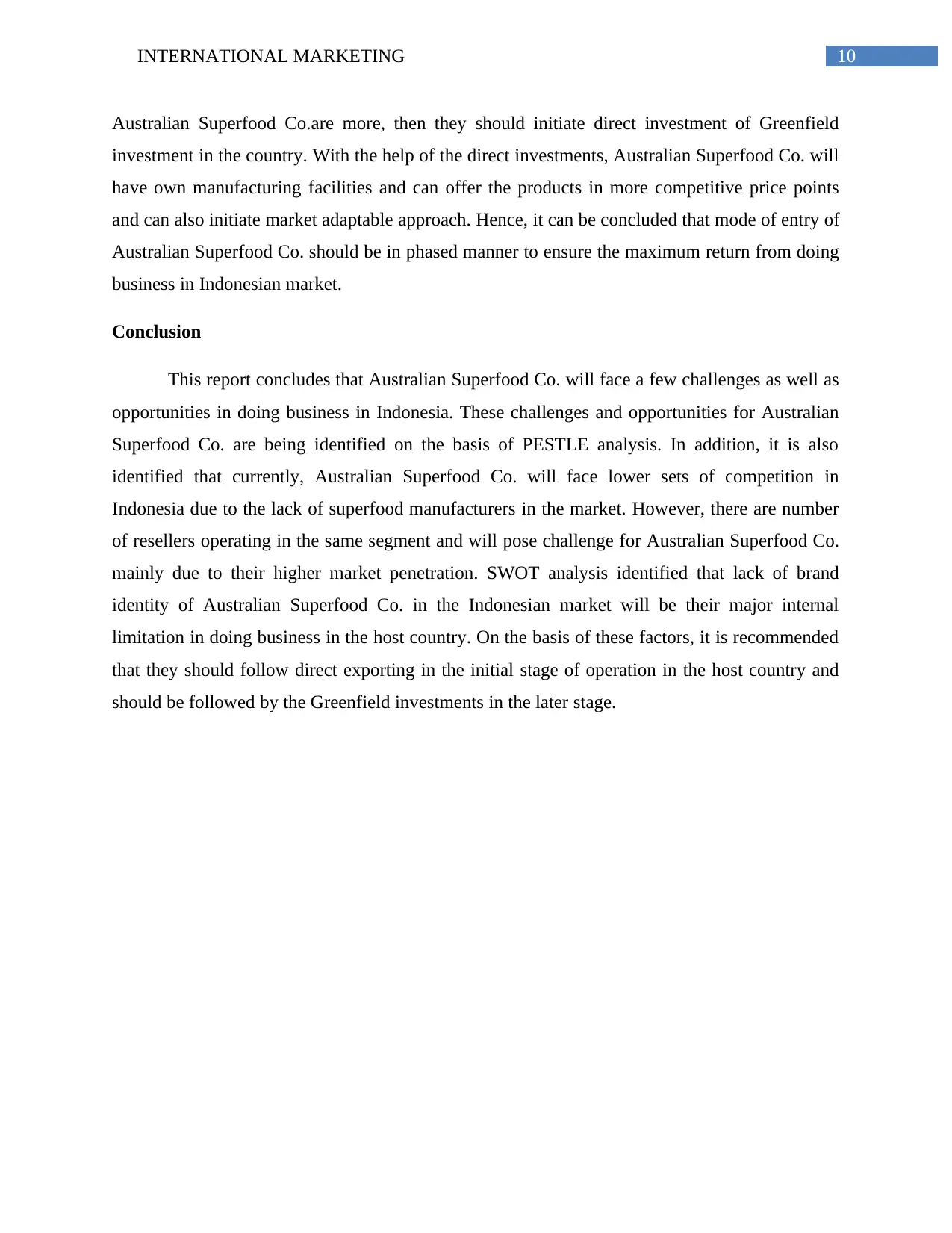
10INTERNATIONAL MARKETING
Australian Superfood Co.are more, then they should initiate direct investment of Greenfield
investment in the country. With the help of the direct investments, Australian Superfood Co. will
have own manufacturing facilities and can offer the products in more competitive price points
and can also initiate market adaptable approach. Hence, it can be concluded that mode of entry of
Australian Superfood Co. should be in phased manner to ensure the maximum return from doing
business in Indonesian market.
Conclusion
This report concludes that Australian Superfood Co. will face a few challenges as well as
opportunities in doing business in Indonesia. These challenges and opportunities for Australian
Superfood Co. are being identified on the basis of PESTLE analysis. In addition, it is also
identified that currently, Australian Superfood Co. will face lower sets of competition in
Indonesia due to the lack of superfood manufacturers in the market. However, there are number
of resellers operating in the same segment and will pose challenge for Australian Superfood Co.
mainly due to their higher market penetration. SWOT analysis identified that lack of brand
identity of Australian Superfood Co. in the Indonesian market will be their major internal
limitation in doing business in the host country. On the basis of these factors, it is recommended
that they should follow direct exporting in the initial stage of operation in the host country and
should be followed by the Greenfield investments in the later stage.
Australian Superfood Co.are more, then they should initiate direct investment of Greenfield
investment in the country. With the help of the direct investments, Australian Superfood Co. will
have own manufacturing facilities and can offer the products in more competitive price points
and can also initiate market adaptable approach. Hence, it can be concluded that mode of entry of
Australian Superfood Co. should be in phased manner to ensure the maximum return from doing
business in Indonesian market.
Conclusion
This report concludes that Australian Superfood Co. will face a few challenges as well as
opportunities in doing business in Indonesia. These challenges and opportunities for Australian
Superfood Co. are being identified on the basis of PESTLE analysis. In addition, it is also
identified that currently, Australian Superfood Co. will face lower sets of competition in
Indonesia due to the lack of superfood manufacturers in the market. However, there are number
of resellers operating in the same segment and will pose challenge for Australian Superfood Co.
mainly due to their higher market penetration. SWOT analysis identified that lack of brand
identity of Australian Superfood Co. in the Indonesian market will be their major internal
limitation in doing business in the host country. On the basis of these factors, it is recommended
that they should follow direct exporting in the initial stage of operation in the host country and
should be followed by the Greenfield investments in the later stage.
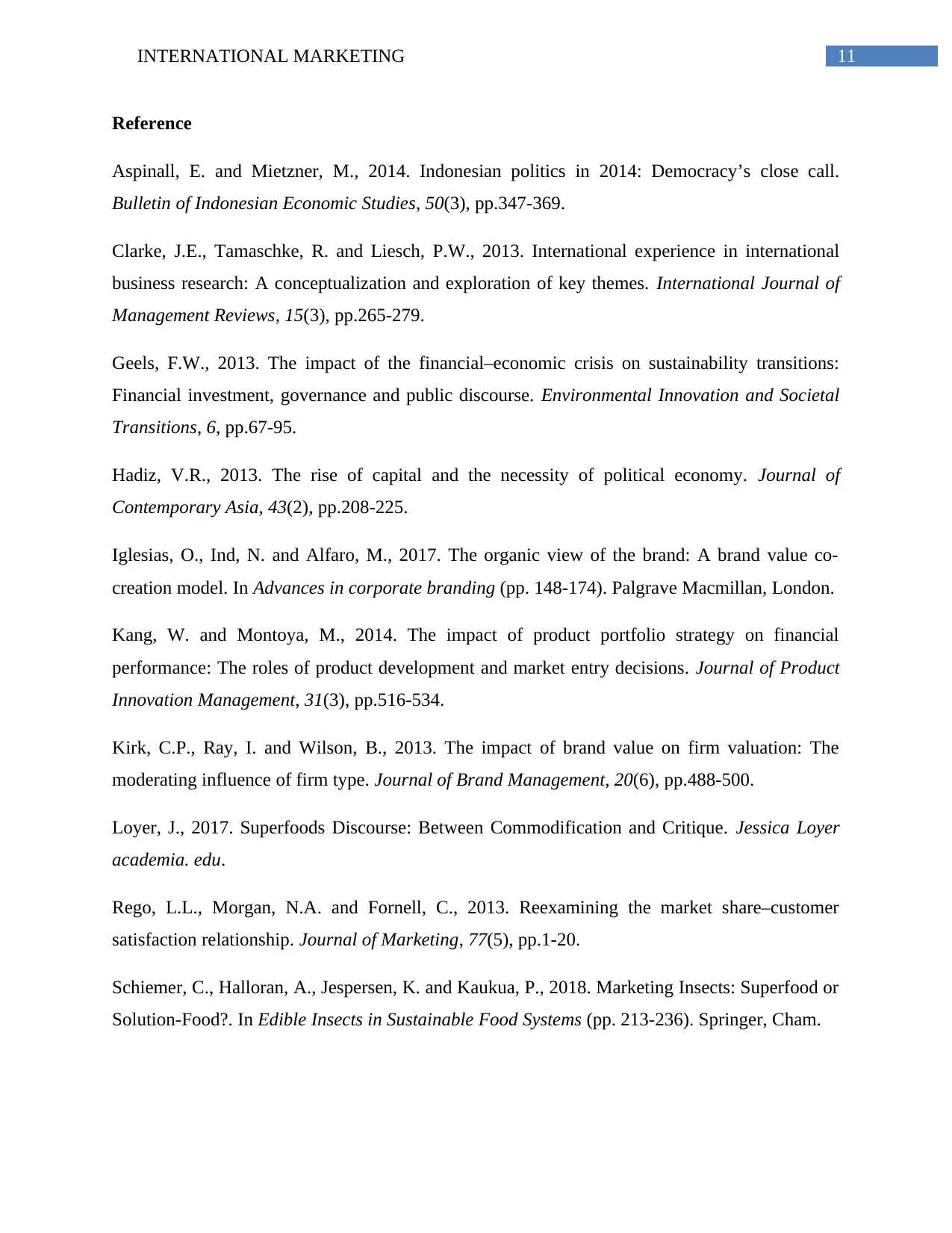
11INTERNATIONAL MARKETING
Reference
Aspinall, E. and Mietzner, M., 2014. Indonesian politics in 2014: Democracy’s close call.
Bulletin of Indonesian Economic Studies, 50(3), pp.347-369.
Clarke, J.E., Tamaschke, R. and Liesch, P.W., 2013. International experience in international
business research: A conceptualization and exploration of key themes. International Journal of
Management Reviews, 15(3), pp.265-279.
Geels, F.W., 2013. The impact of the financial–economic crisis on sustainability transitions:
Financial investment, governance and public discourse. Environmental Innovation and Societal
Transitions, 6, pp.67-95.
Hadiz, V.R., 2013. The rise of capital and the necessity of political economy. Journal of
Contemporary Asia, 43(2), pp.208-225.
Iglesias, O., Ind, N. and Alfaro, M., 2017. The organic view of the brand: A brand value co-
creation model. In Advances in corporate branding (pp. 148-174). Palgrave Macmillan, London.
Kang, W. and Montoya, M., 2014. The impact of product portfolio strategy on financial
performance: The roles of product development and market entry decisions. Journal of Product
Innovation Management, 31(3), pp.516-534.
Kirk, C.P., Ray, I. and Wilson, B., 2013. The impact of brand value on firm valuation: The
moderating influence of firm type. Journal of Brand Management, 20(6), pp.488-500.
Loyer, J., 2017. Superfoods Discourse: Between Commodification and Critique. Jessica Loyer
academia. edu.
Rego, L.L., Morgan, N.A. and Fornell, C., 2013. Reexamining the market share–customer
satisfaction relationship. Journal of Marketing, 77(5), pp.1-20.
Schiemer, C., Halloran, A., Jespersen, K. and Kaukua, P., 2018. Marketing Insects: Superfood or
Solution-Food?. In Edible Insects in Sustainable Food Systems (pp. 213-236). Springer, Cham.
Reference
Aspinall, E. and Mietzner, M., 2014. Indonesian politics in 2014: Democracy’s close call.
Bulletin of Indonesian Economic Studies, 50(3), pp.347-369.
Clarke, J.E., Tamaschke, R. and Liesch, P.W., 2013. International experience in international
business research: A conceptualization and exploration of key themes. International Journal of
Management Reviews, 15(3), pp.265-279.
Geels, F.W., 2013. The impact of the financial–economic crisis on sustainability transitions:
Financial investment, governance and public discourse. Environmental Innovation and Societal
Transitions, 6, pp.67-95.
Hadiz, V.R., 2013. The rise of capital and the necessity of political economy. Journal of
Contemporary Asia, 43(2), pp.208-225.
Iglesias, O., Ind, N. and Alfaro, M., 2017. The organic view of the brand: A brand value co-
creation model. In Advances in corporate branding (pp. 148-174). Palgrave Macmillan, London.
Kang, W. and Montoya, M., 2014. The impact of product portfolio strategy on financial
performance: The roles of product development and market entry decisions. Journal of Product
Innovation Management, 31(3), pp.516-534.
Kirk, C.P., Ray, I. and Wilson, B., 2013. The impact of brand value on firm valuation: The
moderating influence of firm type. Journal of Brand Management, 20(6), pp.488-500.
Loyer, J., 2017. Superfoods Discourse: Between Commodification and Critique. Jessica Loyer
academia. edu.
Rego, L.L., Morgan, N.A. and Fornell, C., 2013. Reexamining the market share–customer
satisfaction relationship. Journal of Marketing, 77(5), pp.1-20.
Schiemer, C., Halloran, A., Jespersen, K. and Kaukua, P., 2018. Marketing Insects: Superfood or
Solution-Food?. In Edible Insects in Sustainable Food Systems (pp. 213-236). Springer, Cham.
⊘ This is a preview!⊘
Do you want full access?
Subscribe today to unlock all pages.

Trusted by 1+ million students worldwide
1 out of 13
Related Documents
Your All-in-One AI-Powered Toolkit for Academic Success.
+13062052269
info@desklib.com
Available 24*7 on WhatsApp / Email
![[object Object]](/_next/static/media/star-bottom.7253800d.svg)
Unlock your academic potential
Copyright © 2020–2025 A2Z Services. All Rights Reserved. Developed and managed by ZUCOL.





